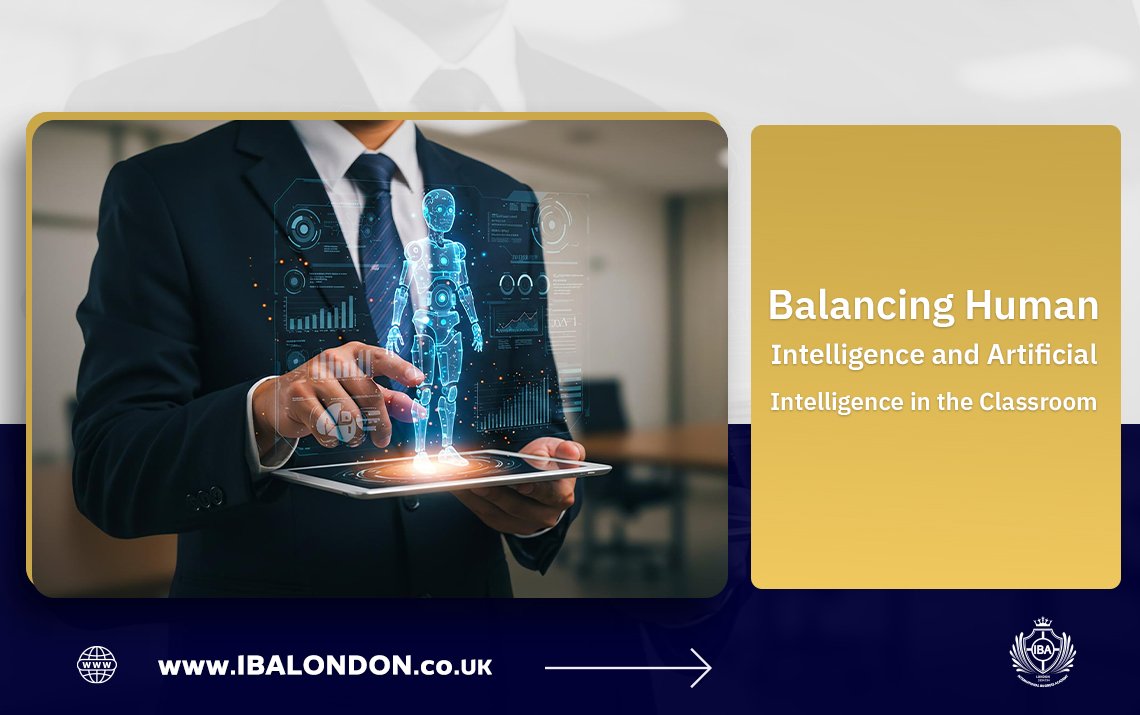
Balancing Human Intelligence and Artificial Intelligence in the Classroom
Balancing Human Intelligence and Artificial Intelligence in the Classroom
In a world transformed by automation, data, and digital technology, the rise of Artificial Intelligence (AI) has brought both excitement and uncertainty to the field of education. AI-powered tools now write essays, grade assignments, translate languages, and even offer personalised tutoring. Yet, amid all the innovation, one truth remains unchanged — education is fundamentally a human endeavour.
For institutions like IBA London LTD, which prepare students for leadership in global business and management, the real question isn’t whether AI belongs in the classroom, but how to balance it — how to ensure that human intelligence, creativity, and ethics remain at the heart of learning, even as we embrace the power of technology.
1. The New Age of Learning
The last few years have seen an explosion in the use of AI within education. Intelligent tutoring systems, chatbots, automated assessments, and predictive analytics are now commonplace. These technologies can analyse learning patterns, identify weaknesses, and deliver content at a pace tailored to each student’s needs.
This represents a profound shift. Traditionally, education has followed a one-size-fits-all model, where students move through content at the same pace. AI challenges that model by enabling personalised learning — giving each student an individualised pathway to mastery.
For IBA London LTD, which caters to diverse learners from across the world, this potential is exciting. AI can support multilingual students, provide flexible digital learning experiences, and assist tutors in tracking progress efficiently. It can help ensure that no learner gets left behind.
But as AI tools become more capable, the question arises: if machines can do so much, what role is left for human intelligence?
2. The Irreplaceable Human Element
While AI can process vast amounts of data and perform repetitive tasks flawlessly, it cannot replicate the depth of human understanding, empathy, and creativity. A teacher’s intuition — the ability to sense when a student is struggling emotionally, or to inspire confidence at the right moment — cannot be programmed.
Human intelligence thrives in ambiguity, emotion, and ethical reasoning — precisely the areas where AI still falters. Business and management education, in particular, requires these soft yet powerful capabilities: negotiation, critical thinking, moral judgment, and leadership under uncertainty.
AI might simulate aspects of conversation or reasoning, but it cannot grasp the moral weight of decision-making, nor can it model the nuances of human culture, relationships, or motivation. These are distinctly human dimensions of learning that institutions like IBA London LTD must continue to nurture.
3. The Strengths of Artificial Intelligence in Education
To balance AI effectively, we must first recognise what it does best. In education, AI brings several clear advantages:
- Personalisation: AI can adapt to each learner’s pace and style, helping students grasp complex topics more efficiently.
- Feedback and assessment: Automated tools can provide instant, data-driven feedback, allowing students to learn from mistakes faster.
- Administrative efficiency: Educators can offload repetitive tasks like grading or attendance tracking, freeing time for deeper engagement with students.
- Accessibility: AI technologies can assist learners with disabilities through speech-to-text, translation, or voice assistance.
- Data-driven insight: Analytics can identify trends in learning outcomes and help educators refine teaching strategies.
When used well, AI becomes an educational ally — one that amplifies teachers’ capabilities rather than replaces them.
4. The Risks of Over-Reliance on AI
However, as AI tools grow more powerful, over-reliance poses real risks. If students depend too heavily on AI-generated answers, they may lose the ability to think critically or independently. Similarly, teachers who outsource too much of their planning to AI might unintentionally weaken the creative and personal dimensions of education.
Three key dangers stand out:
- Erosion of critical thinking: When answers come instantly from AI, students risk accepting information uncritically. True learning requires struggle, questioning, and exploration — all of which develop human reasoning.
- Ethical and data concerns: AI systems rely on vast datasets that may contain bias. If left unchecked, these biases can reinforce stereotypes or lead to unfair outcomes in educational assessment.
- Loss of human connection: Education is as much about relationships as it is about content. If AI replaces too much of the teacher-student interaction, the classroom risks becoming mechanical and impersonal.
AI should enhance learning, not dictate it. The goal for institutions like IBA London LTD must be to find equilibrium — where technology empowers both students and educators without undermining human depth.
5. The Balance: Partnership Between Human and Machine
The most effective classrooms of the future will not be led by AI alone or humans alone, but by a partnership between the two.
Imagine a business management course where AI analyses market data in real-time, helping students simulate decision-making under pressure. The AI can process trends, predict outcomes, and provide instant feedback. Yet the professor’s role is not diminished — it becomes more strategic. The educator guides interpretation, challenges assumptions, and sparks debate about ethics, context, and long-term vision.
This is the future IBA London LTD envisions: classrooms where AI handles the mechanics of learning, and human educators handle the meaning of learning.
In such an environment:
- AI becomes a teaching assistant, not a teacher.
- Students develop AI literacy — learning how to use, question, and evaluate AI output critically.
- How do weEducators focus on coaching, mentoring, and creative problem-solving, leveraging the data AI provides to tailor human guidance.ensure students don’t misuse AI for academic dishonesty?
6. Teaching AI Literacy: The New Core Skill
Just as the industrial era required literacy in reading and writing, the digital era demands literacy in AI. Students today must understand how AI systems work, their capabilities and limitations, and the ethical implications of using them.
AI literacy means being able to:
- Evaluate AI-generated information for accuracy and bias.
- Use AI tools responsibly for research and productivity.
- Understand data privacy and ethical considerations.
- Maintain human judgment in decision-making.
IBA London LTD’s business and management students, for example, will increasingly encounter AI-driven systems in finance, marketing, and operations. The ability to collaborate intelligently with machines will be a defining career skill. Teaching AI literacy ensures that students lead technology — not the other way around.
7. Educators as Curators and Mentors
In the age of AI, the educator’s role shifts from being the primary source of knowledge to being the curator of knowledge. Information is abundant; what students need is context, guidance, and wisdom.
Teachers at forward-looking institutions like IBA London LTD become mentors who:
- Help students navigate the flood of AI-generated content.
- Teach them to question, compare, and interpret information.
- Encourage reflection on ethics, purpose, and human impact.
This mentorship cannot be replaced by an algorithm. It requires empathy, storytelling, and a deep understanding of human potential. The balance, therefore, lies in allowing AI to handle efficiency — while teachers handle meaning.
8. The Ethical Imperative
As education integrates AI, ethical responsibility becomes central. Institutions must consider questions like:
- How is student data stored and used?
- Are AI assessments fair and transparent?
- How do we ensure students don’t misuse AI for academic dishonesty?
IBA London LTD recognises that ethics is not an afterthought but a foundation. The integration of AI into education must be guided by human values — fairness, respect, accountability, and trust.
9. The Future Classroom: Human Insight, Machine Precision
The classroom of the future won’t look like a scene from science fiction. Instead, it will be a dynamic ecosystem where human and artificial intelligence coexist seamlessly.
- AI will provide adaptive learning, administrative efficiency, and real-time analytics.
- Humans will provide mentorship, emotional understanding, creativity, and moral reasoning.
Together, they will create a more personalised, inclusive, and effective education system. Students will learn not only what to think but how to think critically about technology itself — preparing them to become ethical leaders in an AI-driven world.
Conclusion: Keeping Humanity at the Core
AI is transforming education, but it is human intelligence that gives education its soul. Machines can deliver content, but only humans can inspire purpose. Algorithms can process data, but only humans can interpret meaning.
For IBA London LTD, the mission is clear: to prepare students not just to use AI, but to lead in a world shaped by it — combining analytical brilliance with ethical judgment, digital fluency with human empathy.
Balancing human and artificial intelligence isn’t about choosing sides. It’s about creating harmony — where technology amplifies what makes us human, and humanity gives technology its direction.
In the classroom, as in the world, the future belongs to those who can blend the logic of machines with the wisdom of the mind.


